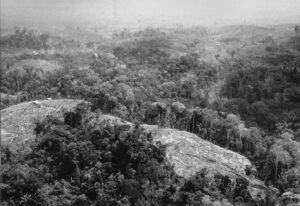Corinne Schmidt
- 1995

Fellowship Title:
- The Cocaine Trade and the Destruction of the Rain Forest
Fellowship Year:
- 1995

Coca Fields: Better than Devastation?
Ichoa, Bolivia – The yap of a toucan sounded from a treetop near the Ichoa ranger post in Bolivia’s Isiboro-Secure National Park. From the cabin’s porch, park director Hans Rocha picked out the bird’s long-billed silhouette, framed against the foothills of the Andes, where the park’s western boundary lies. In the park’s 2.75 million acres, stretching from lowland rain forest to 13,000-foot high mountain slopes, species as common as the toucan and as rare as the harpy eagle thrive. Co-managed by native tribes, who in 1990 won recognition of the park as an “Indigenous Territory,” most of Isiboro-Secure is still pristine. But around Ichoa, in the southeastern corner of the park, the forest has been largely destroyed. Near the ranger post, fallen trees smolder, while in hundreds of other fields, rows of green bushes have replaced the rain forest. They are among the estimated 15,000 acres of parkland burned down to make way for coca, the raw material for cocaine. A photo taken by Discovery astronauts in 1991 shows the thick haze over the central

The Dialogue of the Deaf Over Coca
Quillabamba, Peru – The decrepit old theater, filled with hand-lettered signs and women in bowler hats passing out coca leaves, seemed worlds away from the high living associated with the illegal drug trade. So did the calls for all-out war on “el narcotráfico.” But its designation of coca as a traditional natural resource of the Andes, like its condemnation of U.S. efforts to eradicate the coca crop, turned the annual congress of the Andean Coca Council into an overt challenge to U.S. drug policy. Alberto Fujimori, president of Peru, has agreed to work with the president of Bolivia to remove coca from a United Nations blacklist. Photo by AP/Wide World “They can’t have it both ways,” a U.S. development official said recently. “They’re either in coca or they’re not.” It was the kind of pat dichotomy that has produced what Peruvians call “a dialogue of the deaf” between coca farmers and counternarcotics officials. For unlike the foreign technocrats sent to fight the drug war, who see coca as merely the raw material for cocaine, Andean

The Lure of a Criminal Cash Crop
TINGO MARIA, Peru. – On her farm in a hollow in Peru’s high jungle, one woman’s pride are her tropical fruit trees. But she acknowledges that fruit doesn’t bring in money in. Nor does the coffee and cacao she and her husband grow. These days, their only cash comes from the hardy green coca bushes whose leaves, when beaten and soaked in chemicals, yield cocaine. A pesant farmer harvests coca leaves in a jungle plot in Peru’s Upper Huallaga Valley. The valley is the world’s single largest source of coca, the raw material of cocaine. Photo by AP/Wide World Photos. Her farm near the town of Tingo Maria is nestled in the Upper Huallaga Valley, an area where the Andes mountains plunge down to the Amazon basin. Here, climate and geography have created a unique zone of upland tropical forests which Peruvians call “the eyebrow of the jungle.” Once a paradise of rolling, forested hills, today the Upper Huallaga, covering an area just smaller than New Jersey, is best known for its most infamous crop
